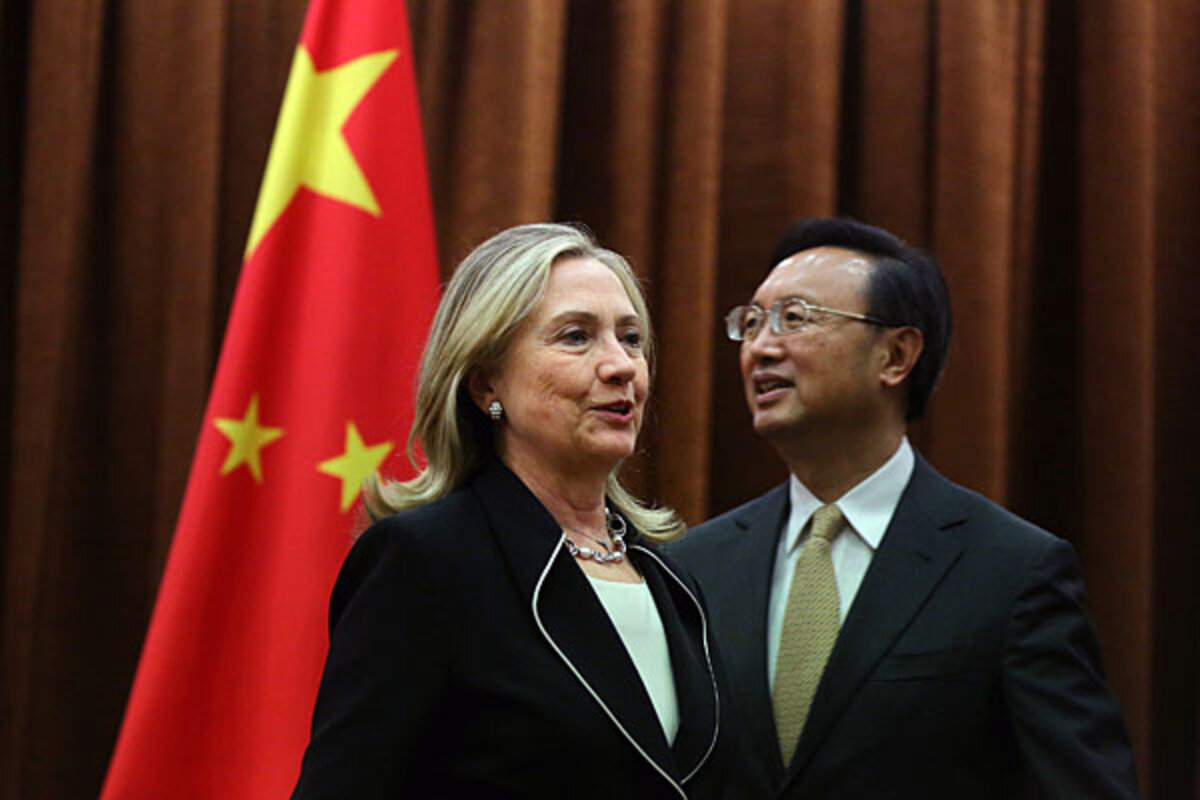Hillary Clinton in Asia: Are US goals on China realistic?
Loading...
| Washington
Hillary Clinton’s 11-day Asia-Pacific tour will take in six countries by the time she arrives in Vladivostok, Russia, on Saturday, but the trip is all about China.
In her meetings in Beijing Tuesday and Wednesday with senior Chinese officials, including President Hu Jintao, the US secretary of state is addressing issues ranging from competing territorial claims in the South China Sea to Syria, Iran, and North Korea.
But the over-arching theme of the Beijing visit, as for much of the rest of the trip, is the Obama administration’s long-term objective of seeing a rising China emerge as a responsible and contributing leader in international affairs, and as a force for stability and prosperity – rather than for conflict – in the resource- and trade-rich Southeast Asia region.
The problem Secretary Clinton confronts in Beijing, and that the US faces more broadly, is that China does not see that its interests and the goals of the United States line up, some Asia experts say.
“The heart of the effort of this administration, and to be fair, of previous administrations, has been to tell the Chinese what their interests are … and then to think that perhaps we could bring the Chinese around to seeing the world as we do,” says Dean Cheng, a research fellow at the Heritage Foundation’s Asian Studies Center in Washington.
“The flip side,” he adds, “is that the Chinese have a pretty good idea of what their interests are, and those interests very often do not align with those of the United States.”
Those differing interests are likely to surface over two key topics of Clinton’s visit: the mounting tensions over territorial disputes in the Asia-Pacific region, and particularly in the South China Sea, and Syria.
Clinton arrives in China from Indonesia, where she once again emphasized the US position: that while the US has no territorial claims in the region, it does have considerable economic and national-security interests in seeing one of the world’s most prosperous regions stable and open to international trade.
“The US has a national interest … in the maintenance of peace and stability, respect for international law, freedom of navigation, [and] unimpeded lawful commerce in the South China Sea,” she said at a press conference Monday. “The US does not take a position on competing territorial claims,” she added, “but we believe the nations of the region should work collaboratively to resolve disputes without coercion, without intimidation, and certainly without the use of force.”
That position was met with a certain amount of skepticism in Beijing, where before Clinton arrived Tuesday, Foreign Ministry spokesman Hong Lei said that the US “has many times said it does not take a position” on the region’s territorial disputes. “I hope they will keep their promise,” he added, “and do more to help stability and not the opposite.”
Mr. Hong left no doubt about China’s position on the territorial disputes, saying, “China, like other countries in the world, has the obligation to safeguard its territories.”
The US is advocating a multilateral and diplomatic solution to the region’s territorial disputes, starting with adoption by the region of a “code of conduct” for resolving competing claims in the resource-rich South China Sea basin short of the aggressive measures.
China, as the region’s economic and military behemoth, prefers to address each dispute bilaterally. “From their perspective, multilateralism works against them,” says Mr. Cheng of Heritage.
And Beijing signaled what it thinks of a multinational code of conduct that would rule out aggressive action in July, when it announced construction of a city and stationing of a military garrison on a remote island 220 miles from the southernmost tip of mainland China.
The island is in an area also claimed by the Philippines and Vietnam, and known to be rich in oil and gas deposits.
Cheng notes that the idea of a “code of conduct” for the region has been around for a long time, but he says that divisions among Southeast Asia’s smaller countries work to Beijing’s benefit. “There is a real split between maritime Southeast Asia and continental Southeast Asia, or basically between those [countries] who are more clearly aligned with China, and the rest.”
On the larger world stage, China has also dismayed the US by siding with Russia three times on vetoes of United Nations Security Council action that would have punished Syrian President Bashar al-Assad for violence targeting civilians.
Some regional analysts have said that China’s aim in shielding Mr. Assad from international pressure is murky, given China’s lack of the kind of geopolitical interests in Syria that Russia has.
But Cheng says that China’s leadership has been observing the Arab Spring, and in particular the descent of Syria into civil war, and is left contemplating two “fundamental concerns” that strike close to home. “They see a rising tide of anti-authoritarianism, and … they see this idea of leadership instability.”
Noting that China is in the middle of a delicate power transition of its own this year, Cheng says “the last thing the [Communist] party wants” is to do anything that would encourage either of these tendencies in China.
Understanding China’s stance on Syria is easier, he says, when one considers that the crumbling of Syria’s authoritarian regime and the attacks against a secular Assad by an Islamist movement have the leadership in Beijing wondering, “Could this wave eventually lap at China’s shores?”





